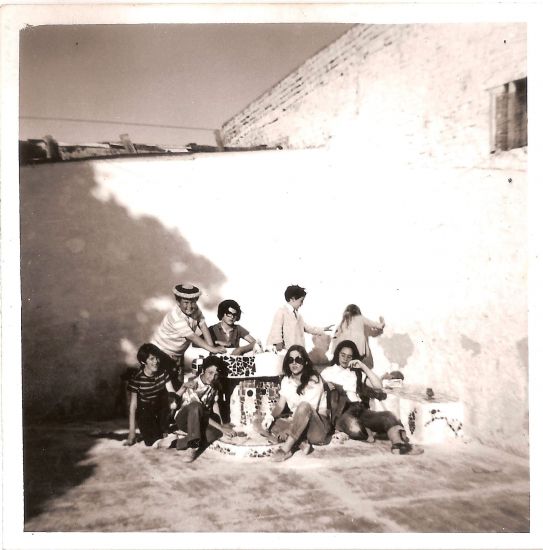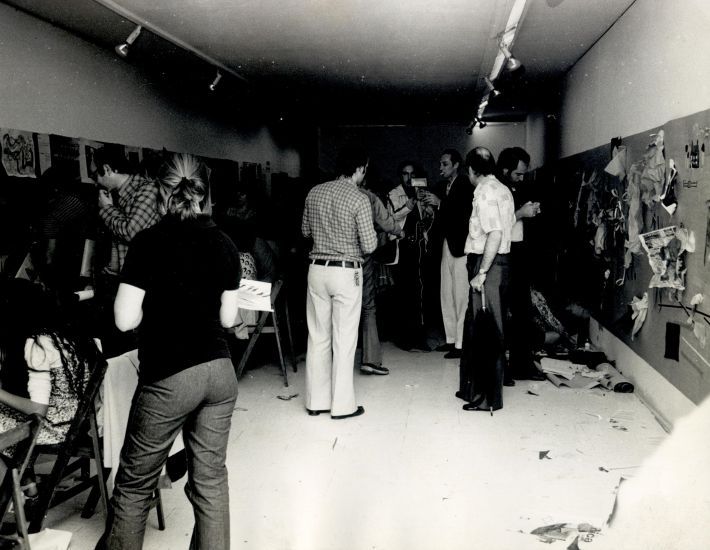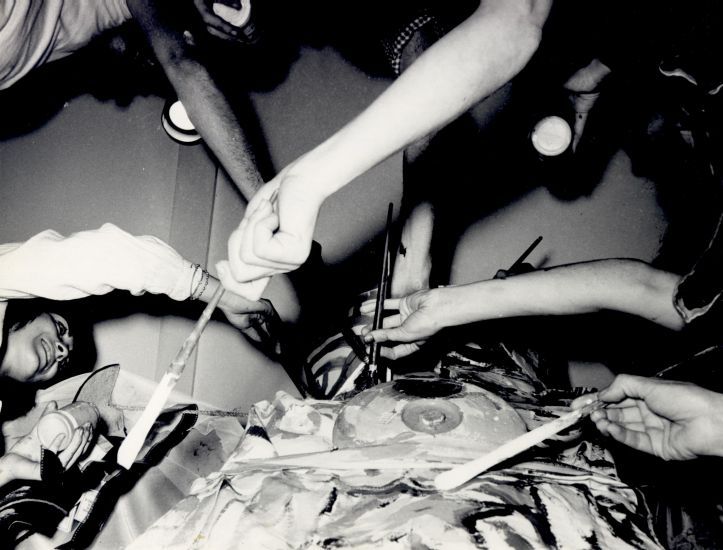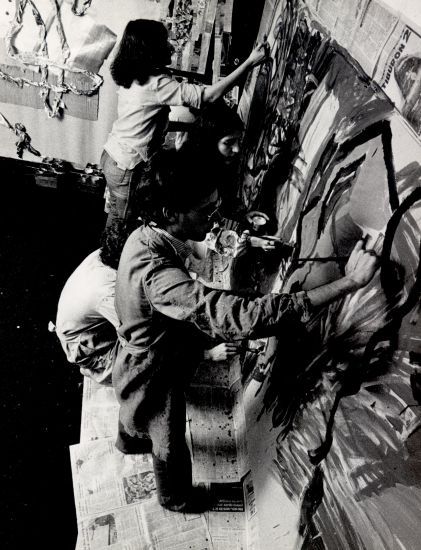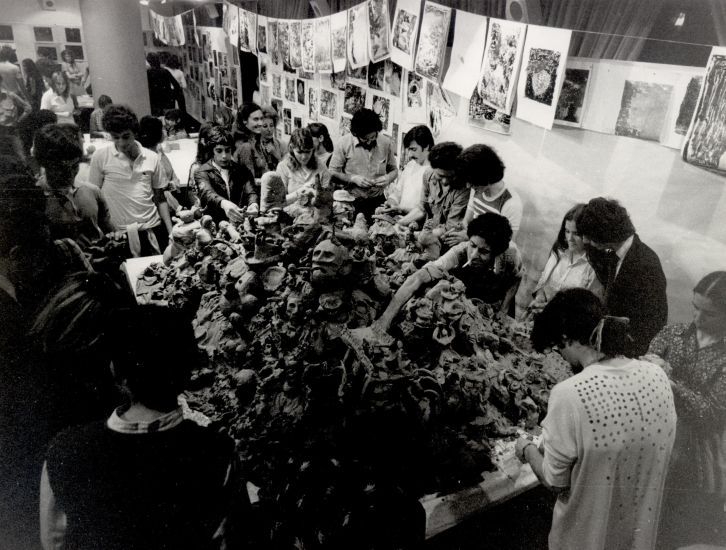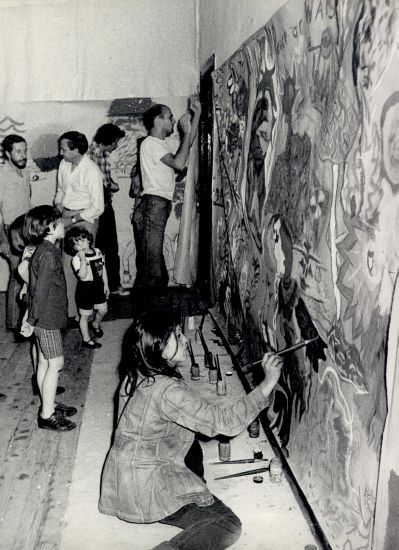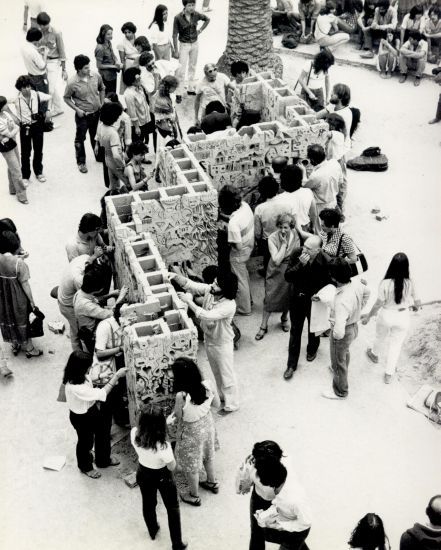Mirtha Dermisache, in the middle of her artistic career, began to develop an intense pedagogical work in parallel, with her own method, especially designed to work with adults, from individual to collective projects, until taking, at various times, a public dimension. We present her work in a brief timeline.
1971
In 1971 Mirtha Dermisache opened the doors of the Taller de Acciones Creativas (TAC), a space for the teaching of different plastic techniques, which initially worked at her house and later moved to Posadas 1209. The proposal consisted of experiencing, experimenting and working with different techniques with the aim of developing the creative capacity and free graphic expression in adults. In the group classes, the attendees were provided with all the materials and tools they needed to work.
1974Carmen Waugh Gallery
As an extension of TACs activity and following its spirit, a free public experience was held at the Carmen Waugh Gallery on December 26 and 27, 1974, which would give rise to the Jornadas del Color y de la Forma. As in the workshop, the objective was to express oneself freely, to let out the inner gesture, without worrying about what to do or how.
On their posters you could read:
Puede la gente grande expresarse con las técnicas de los chicos? Nosotros creemos que si. Lo haremos todos juntos [Can grown-ups express themselves using the techniques children use? We believe they can. We will do it all together].
1975Museo de Arte Moderno
After the success of the pilot experience carried out in 1974, the TAC, under the coordination of Mirtha Dermisache, organized the first Jornadas del Color y de la Forma. It was held on July 4, 5 and 6, 1975 at the Museo de Arte Moderno in Buenos Aires, which was housed in the current Teatro San Martín (on the ninth floor). This free activity was geared to an audience, with or without artistic training, who wanted to experience various plastic techniques, individually or in groups, and with the aim of “liberar la capacidad creadora” ["releasing the creative capacity"]
In the museum space, open from 5:00 p.m. to 8:30 p.m., there were large tables with various materials to work on. The collaborators explained to those who came to participate how the different techniques should be used, without making aesthetic judgments about what was done. The atmosphere was one of play and relaxation.
1976Museo de Arte Moderno
The Segundas Jornadas del Color y de la Forma were held almost an year after the first Jornadas, months after the last military dictatorship began in Argentina. They were also organized at the Museo de Arte Moderno in Buenos Aires, from June 15 to 19, 1976 between 6:00 p.m. and 8:30 p.m.
A diverse audience attended in terms of age (over 16), gender and social class. They were summoned by the motto:
"El museo se transforma en un gran taller de acciones creativas, sólo para adultos". [The museum will be turned into a great workshop of creative activities, for adults only.]
Some knew about the experience of previous editions, others arrived thanks to the recommendation of a friend, in response to the posters or simply because of the queue that was made at the door. Inside, some just watched, while others got lost in the activity. There was a climate of freedom in a political context marked by censorship.
1976Museo de Arte Moderno
The Terceras Jornadas del Color y de la Forma were held three months after the previous ones, and covering more days, from September 7 to 11, and from September 14 to 18, 1976, again at the headquarters of the Museo de Arte Moderno in Buenos Aires .
On this occasion, nine large trestle tables, each with its coordinators and its materials, occupied the room. Each participant could choose what to do with the materials and even with their finished work (leave it or take it with them). On the walls that surrounded the space were hanging previous works as varied as the attendees that multiplied with each new edition.
1977Museo de Arte Moderno
The following year, in August 1977, the Cuartas Jornadas del Color y de la Forma were held, again at the Museo de Arte Moderno in Buenos Aires. The call was larger, also the number of collaborators, former students of Mirtha´s Workshops.
On this occasion, the central premise, which conveys the spirit of the Conference, was:
“Con nosotros no van a aprender ni a dibujar, ni a pintar, ni historia del arte, ni sistema de composición y análisis de obra. Sólo les explicaremos técnicas.¿Todos los que somos adultos hemos tenido acceso a una libre expresión gráfica durante nuestra infancia?
¿Por qué cuando el adulto tiene ganas de expresarse graficamente debe recurrir a un aprendizaje racional y sistematizado?
Rescatemos el mundo de formas que tenemos encerrado dentro nuestro y reconozcamosnos en ellas. Para nosotros no hay trabajos buenos o malos, lindos o feos, hay diferentes formas de expresarte. Prolonguemos nuestro gesto interno en la herramienta de trabajo. No importa lo que pasa en la hoja de papel: lo importante es lo que pasa dentro nuestro.” ["We will not teach you how to draw or how to paint; you won’t learn about art history, composition systems, or art appreciation. All we will do is explain techniques. As children, did those of us who are now adults have access to free graphic expression? Why is it that when an adult is inclined to graphic expression he must resort to a rational and systematized learning process? We will release the world of forms locked inside and recognize ourselves in them. There are no good or bad, pretty or ugly, works in our view; there are different ways of expressing oneself. We extend our inner gesture in the work tool. What happens on the page does not matter: what matters is what happens within us"].
1979Museo Sívori
Between the previous Jornadas and those of 1979, more than two years passed. Mirtha testified that her personal exhaustion was very great because the Jornadas were increasingly massive, and also that the planning of the following ones required more and more resources, therefore, rethinking financing. Just in October 1979, the Quintas Jornadas were held at the Museo de Artes Plásticas Eduardo Sívori, Buenos Aires. In this case, they were sponsored by a series of companies that donated material to work with (paint, clay, sponges, ink, paper, fabrics, etc.)
As in previous editions, Mirtha Dermisache, director of the project, proposed opening a space for the public to develop free graphic expression, so common among children but usually forbidden to adults. The purpose was not to draw, nor to make works of art but to play and express themselves freely.
The proposal was very well received among young people and adults, even the organizers calculated that around 500 people attended at the same time and that sometimes you had to stand in a long line to enter. Once inside, the participants could choose between the different techniques available, assisted by an assistant belonging to the TAC, out of the 100 available.
1980Centro de Arte Di Tullio
The success of the previous Jornadas led to a proposal to be carried out in the city of Bariloche from January 9 to 13, 1980. They were entitled the "Primeras Jornadas del Color y de la Forma de Bariloche" and were consolidated as the only experience of this type outside of Buenos Aires. To do this, a group of members of the Taller de Acciones Creativas traveled before the start with the intention of training twenty-five people who would help in the coordination of the Jornadas and who could in the future act as multiplying agents. On this occasion, the Jornadas were sponsored by the company Aerolíneas Argentina and by the local departments of Tourism and Culture.
In the annex of the Centro de Arte Di Tullio, where they took place, the following techniques were implemented: wet sheets of paper, sponges, individual and joint work in clay, murals in tempera paint, carved brick, and black and white and color monotypes.
The experience was extremely well attended and appreciated by the local community.
1981Centro Cultural Ciudad de Buenos Aires
The Sextas Jornadas del Color y de la Forma were held in the then recently inaugurated Centro Cultural Ciudad de Buenos Aires -currently Centro Cultural Recoleta- and were held on 12 days of November 1981: from 12 to 15, 19 to 22 and 26 to 29. On this occasion, the Jornadas were once again sponsored by Aerolineas Argentinas.
The breadth of the space made possible the incorporation of new techniques, among them the experimentation with audiovisual format, giving the participants cameras to film. Likewise, more than 20 techniques could be carried out, including wet sheets of paper, sponges, aniline dye, benzene, black and white and color monotypes, clay in groups and individually, tempera in groups, finger paint, and brick carving.
The collaborators explained the different techniques to the public, provided the material and answered questions. Once completed, the works were hung on large panels that surrounded the room. As in previous editions, the intention was to release the creative force that all human beings have, through contact with free graphic expression.
The enormous participation of the public in the Sextas Jornadas (it is estimated that around 18,000 people attended) added to the enormous repercussion it had in the media, especially graphics, generated controversies in the artistic field.
In 1982, a round table was held at the Fundación San Telmo, the aim of which was to assess the achievements and projection of the Sextas Jornadas del Color y de la Forma. Participants included: Jorge Romero Brest, Gregorio Klimowsky, Nelly Perazzo and Emilio Renart. Silvia Puente moderated. The debate revolved, among other things, around whether or not the Jornadas could be considered an artistic event and whether or not they could be envisioned of as a form of knowledge.
Somehow, by not continuing the experience in subsequent years, the Sextas Jornadas were known as “the last Jornadas”, but there is no documentation that accounts for them having been created as such, but only testimonies of the enormous work and exhaustion of their production. Also around 1983 Mirtha took a hiatus in her career, in which she took a break from all her activities.
